France restarted domestic production of the Junkers Ju-52 transport after WWII. Although intended as a quick, cheap stop-gap solution, the AAC.1 Toucan fought in three post-WWII conflicts and quietly served as long after WWII as the famous original Junkers did before and during WWII.

(Junkers Ju-52s of the Luftwaffe training Fallschirmjäger during WWII.)
 (A French air force AAC.1 Toucan – the post-WWII French copy of the Ju-52 – flies over a burning Vietnamese jungle during the Indochina War.)
(A French air force AAC.1 Toucan – the post-WWII French copy of the Ju-52 – flies over a burning Vietnamese jungle during the Indochina War.)

(A French air force AAC.1 Toucan in Africa during the 1950s Algerian War.)
Tante Ju
The Junkers Ju-52 transport served Germany all of WWII from start to finish and was, by a huge margin, the Luftwaffe’s main transport both in total built and as a percentage of types operational at any given point of WWII. German servicemen called it “Tante Ju” (“Aunt Junkers”).
Specifically speaking, the plane most everybody thinks of is properly referred to as the Ju-52/3m as the original early-1930s Ju-52 design was a single-engine type. Unless otherwise needed for clarity, most people just call the trimotor “Ju-52” and for brevity’s sake, that will be done here.

(Overhead view of a French navy AAC.1 Toucan, showing the classic lines of the Junkers Ju-52 with stood-off, full-length control surfaces. Called “doppelflügel”, these functioned as ailerons, flaps, and airbrakes.)
The Ju-52 was 62′ long with a 96′ wingspan. It was powered by three BMW 132 engines with a maximum speed of 149 kts and a loaded cruising speed of 113 kts. The wing engines were seated perpendicular to the wing’s back-swept trailing edge, leading to the impression that they “pointed outwards”; this arrangement being selected so that the plane could be easier controlled with asymmetric thrust if one engine failed.
The Ju-52 had corrugated aluminum skin. During the 1920s / early 1930s, working aluminum to sufficient crashworthy strength was still a young science in the aviation field. Corrugation resulted in more strength than flat aluminum sheets with reinforcing frames, but, it was also more expensive and added a significant drag penalty to the airplane’s top speed. Hence by WWII its popularity had already ended.

(The corrugated skin of the AAC.1.) (photo by Ralph Evain)
Originally a 17-seat airliner for Lufthansa, the Ju-52 had obvious military potential and was adapted into an 18-seat transport with two or four defensive guns.

(In France, Wibault’s 280 Series – shown here, the W-P.281T – was a trimotor competitor of the Ju-52 before WWII. It was a commercial flop and less than two dozen were sold. Like the Ju-52, it was pressed into military transport service when WWII started and was a failure in that role too.)
Prior to WWII the Ju-52 had been used experimentally in South America as a makeshift bomber. During the 1939 invasion of Poland, the Luftwaffe was short of bombers and adapted Ju-52s to this role with a ½-ton bombload. Early production versions of the Ju-52 had a basic trap-door bomb bay system in the cabin. However contrary to some writings today, this was not the “original” or “intended” envisioned mission for the Ju-52.
Junkers never really replaced the design. Lufthansa planned to replace the Ju-52, when WWII ended, with the civilian Ju-252 which first flew in 1941. As the war was nowhere even close to being won in 1941, only 15 were made and all went to military service. Another would-be WWII replacement, the Ju-352, was intended for military use but only 43 were made.

(This Ju-352 was one of seven completed from leftover parts in Czechoslovakia after WWII and was presented as a gift to the Soviet military.)
Production of Ju-52s continued until the autumn of 1944 when Germany suspended cargo airplane production to concentrate on fighters.
what was Amiot

The Toucans were built by the post-WWII remains of the Amiot company. It was founded by Felix Amiot of the SECM (Society of Stamping & Mechanical Construction) concern. The company’s main factories were at Caudebec in Normandy and at Colombes, a northern suburb of Paris. Prior to WWII, the company’s “claim to fame”, if one can call it that, was the Amiot 143 medium bomber; regarded – then & now – amongst the ugliest warplanes ever flown.
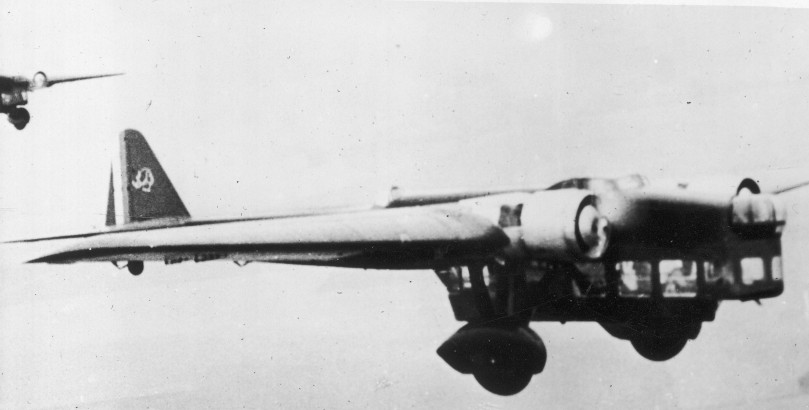
As WWII began in September 1939, the company was gearing up for the Amiot 351/354 tactical bomber. A total of 830 were on order for the French air force. However nine months into WWII, only about five dozen had been completed with another 200+ under construction. Three were shot down during the 1940 German invasion and another ten were lost to other causes. After the armistice production was cancelled by the Germans and survivors were ripped apart to recover parts usable elsewhere, as were the many incomplete planes.

(unfinished Amiot 351 bombers)
Germany made use of aerospace factories in conquered countries, and in late 1941 plans were drawn up to begin Ju-52 production at the former Amiot factory in Colombes. At the same time, a factory formerly of the Gnome & Rhône company was requisitioned to make BMW 132T engines, in conjunction with a Hispano-Suiza motor factory also in Colombes. Mass production of Ju-52s in occupied France started in 1942.

(The Gnome & Rhône factory was bombed during WWII and by 1945 was in rougher shape than this pre-WWII photo.)
The Ju-52 was not the only Luftwaffe type built under this arrangement. The Si-204 transport was built at the former Hanriot factory, the Fi-156 Storch by Morane-Saulnier, the Ar-196 seaplane at the former SNCA-Ouest plant, and the Bf-108 Taifun and Do-24 seaplane in former Potez factories; amongst other types.
In token exchange for this involuntary use of French aerospace factories, Germany allowed a small amount of warplane production for the Vichy regime’s military, until that agreement was terminated in November 1942.

(The Lioré-et-Olivier LeO 451 bomber was one of the types allowed limited Vichy production as described above. A total of 67 survived WWII and were used by France in secondary roles until 1957. This was the final pre-occupation bomber of French origin in NATO-era service, and the final LeO-branded warplane of any sort in service as the former company’s assets had been rolled into SNCASE.)
Of the 4,813 Ju-52s built for the Luftwaffe before or during WWII, 602 (or 12.5% of the total) were manufactured at the former Amiot factory: 40 in 1942, 321 in 1943, and 241 in 1944 before American troops liberated Colombes in August.
At the end of 1944, Amiot’s Colombes factory was reorganized by the French government into Ateliers Aéronautique Colombes, or AAC.

(Ju-52 parts at the former Amiot factory, having been reorganized as Ateliers Aéronautique Colombes, in 1945.)
actual Ju-52s after WWII
Surprisingly some German-built Ju-52s flew on past WWII, mostly in civil use. When WWII started in late 1939, a number of airlines located in what were now the allies had Ju-52s in inventory. These were quickly relocated to out-of-the-way routes (often sub-saharan Africa), as it was obviously unwise to be flying passengers over Britain or France in a Luftwaffe-standard design.
Perhaps the single most famous Ju-52 abroad during WWII was one owned by Sindicato Condor airlines of Brazil. In early 1942, it was taken into US Army inventory and flown by the 20th Transport Squadron out of the Panama Canal Zone. The Junkers Ju-52 occupies the C-79 slot in the US Air Force nomenclature lineage on account of that one airplane. The plane was disliked by American pilots and in December 1943 it transferred from the US Army to the US Public Roads Administration. After WWII it was resold to a civilian in Costa Rica.

(American airmen with the lone C-79 during WWII.)
A few of these pre-war civil Ju-52s continued on after WWII. For example Sabena Airlines flew pre-1939 Ju-52s on routes in central Africa until spare parts ran out in 1947. Others continued in use in Latin America, including TAO airlines in Ecuador which flew German-made Ju-52s into 1958.

(A Ju-52 of LAB airlines in Bolivia, which flew the Ju-52 before, during, and after WWII. Despite a poor safety record with this airline, the last LAB Ju-52 was not retired until 1955.)

(A Ju-52 carcass sits next to a B-17 Flying Fortress wreck in the American occupation zone of Germany after WWII, awaiting scrapping. Most Ju-52s did not survive WWII.)
When Germany surrendered in May 1945, there were still between 150 – 199 Luftwaffe Ju-52s extant; spread from Norway through Czechoslovakia; with the count depending on where one drew the line as “intact”. A few of these were taken by the USSR which passed them to Aeroflot. Others were used in free-world airlines.

(An ex-Luftwaffe Ju-52 refitted for civilian airline use with British European Airways, waiting for passengers at Manchester in 1947. This airline flew ten Ju-52s after WWII, with the last retired in February 1948.)

(Gibbes Sepik Airways flew ex-German Ju-52s in New Guinea during the 1950s. This one was re-engined with Pratt & Whitney Wasps and had parts taken off WWII Wirraway trainers which the RAAF was discarding.) (photo by Brian Horsey)
The lion’s share of surviving Ju-52s was claimed by the UK; 103 planes at the peak. They came in handy as a “gap filler” inbetween the mandatory return/retirement of lend-leased American WWII aircraft after V-J Day, and the availability of enough postwar British planes. Some were refurbished by Fokker in the Netherlands, bringing badly-needed business to that company. Post-WWII British Ju-52s were split up between the RAF, civil aviation, and British industry. In an odd twist, the British warplane company Shorts (a pre-WWII rival of Junkers) operated a handful of ex-Luftwaffe Ju-52s in 1946.

(The Swiss air force operated Ju-52s from 1939 – 1981 and was the final military operator of any variation of the basic design.)
The Swiss, Portuguese, Belgian, South African, Czechoslovak, Colombian, Bulgarian, Norwegian, Polish, Yugoslav, British, and Spanish air forces continued to fly German-built Ju-52s after WWII ended for varying lengths of time – in most cases not very long.
the end of Junkers
In defeated Germany, the main factory of Junkers was in Dessau, which now laid in the Soviet occupation zone; the future East Germany; and was as good as gone. In the future West Germany, the company had a smaller facility at Kassel which had been overrun by American troops on 4 April 1945. After WWII, it was in the USA’s occupation zone and was used as a displaced persons camp.

(The former Kassel facility two years after the end of WWII.)
Surprisingly Junkers as a corporate entity continued to exist on paper throughout the occupation and the period when West Germany was banned from warplane production. In 1956, MBB (the postwar iteration of Messerschmitt) bought a majority interest of the company. Junkers existed as a semi-independent company until 1965, when MBB bought all remaining shares of stock. Thereafter just a brand name within MBB, use of the Junkers trademark was abandoned in 1969.
All this is basically trivial to the AAC.1 story in France as in 1945, the victorious western allies had seized or voided any military-related German patent developed or produced during the Third Reich era, including the Ju-52.
actual Ju-52s in postwar France
The French air force operated two flightworthy Ju-52s while WWII was still ongoing, and then got another 38 when Germany surrendered in May 1945. After production of the AAC.1 started, these were moved into that designation and received the serial numbers 001 through 040 in the postwar French system.

(A captured or surrendered Ju-52 with the French roundel applied over the German balkenkreuz in 1945.)

(A Ju-52 at Dakar, French West Africa. Today the city is in Senegal.)
Some of these were assigned to the transport group III/15 ‘Maine’ which was a mixed bag of surrendered Ju-52s and lend-leased C-47 Skytrains. The first missions of these planes included repatriation flights of allied POWs out of occupied Germany, along with French citizens deported during WWII.
Five were diverted to the French navy, where they relieved transport-converted, pre-occupation Glenn Martin 167F bombers which had amazingly survived WWII.
The French flew these Ju-52s for several years after WWII until they were mechanically worn out, or rebuilt as described below.
restarting production: the AAC.1 Toucan
Like many arms procurement decisions in the first years after WWII, the choice to restart production of the Ju-52 in France was a blend of military value and financial considerations.

(Inside the Colombes factory in October 1945, five months after Germany’s surrender. These would be completed as the first AAC.1 Toucans, but may have been birthed as Ju-52 fuselages before the factory’s 1944 liberation.) (photo via Life magazine)
Militarily the Ju-52 was already obsolete by the end of WWII; outclassed in payload and performance by the C-46 Commando and C-47 Skytrain. None the less, the obsolescence slope of a transport plane is much more gentle than that of a fighter or bomber. The Ju-52 could still reliably move men and supplies from point A to point B. As far as the French were concerned in late 1945, that was good enough.
Financially there were several aspects. During WWII the United States provided free or low-cost aircraft to the Free French via lend-lease or direct gift. However that ended in September 1945. The French obviously had no way of knowing at that moment that another large tranche of American aid would be coming a few years later during the Indochina War, and during the autumn of 1945 it was assumed that all future warplane imports would be at market price.
Imported military aircraft are expensive and a concern the French government had was the disproportionate way they threw off France’s BoP, or Balance of Payments. In economics BoP is the outflow vs inflow of a country’s currency; if the outflow exceeds the inflow it usually weakens the currency and vice-versa. After liberation, the French government had a goal of getting the Franc to somewhere near F6 : $1, but in late 1945 the Franc was trading at less than one American cent. It was therefore preferable to home-build whenever possible, even if the final product was not exactly what the French air force wanted.
As the victorious Allies had seized all of wartime Germany’s patents, production of the Ju-52 was royalty-free; and as German taxpayers had already long since paid the design and development part of the price tag, the cost of each AAC.1 would basically be parts & labor only.

(AAC employees making Toucan parts in late 1945. The factory was laid out to 1920s-vintage industrial concepts.)
There was also a desire to keep aircraft assembly workers, aluminum metalsmiths, etc employed in their fields. If warplanes were being built in France – even an obsolete foreign type – it would limit the “leakage” of unemployed aerospace workers getting other jobs before they could pass their skills to a new generation.
This philosophy was not limited to the Ju-52. While the AAC.1 Toucan is today the best known example, other Luftwaffe designs were pirated in post-WWII France. For example 67 copies of the Ju-88 bomber, designated AAB.1, were built after WWII and served in various roles until 1953.

SNCAC built copies of the Siebel Si-204 at the former Hanriot factory in Bourges, designated NC-701 Martinet. These were successful and flew into the early 1960s.

Morane-Saulnier built copies of the Fieseler Fi-156 Storch after WWII under the name Criquet, with various model numbers (starting with MS.500 for 100% German parts) changing as postwar French equipment was gradually substituted. These were tremendously successful and served into the 1970s, and were also exported, including to Cambodia as shown below.

Far less successful was an attempt to built the Fw-190 fighter. The chosen designation was NC-900.

At the end of WWII France was in possession of 127 Fw-190 fuselages, 162 wing sets, and 190 unmounted BMW 801 engines. From this, it was estimated that 120 complete Fw-190s could be assembled in a one-time shot. However it was found that the WWII parts were of poor manufacturing quality. The NC-900 order was cut from 120 to 65, and then again to 40. The NC-900s were issued to the legendary Normandie-Niéman squadron which absolutely hated them. The trouble-plagued NC-900s flew as first-tier fighters for only 1½ years and were completely retired from second-tier roles in 1949.
France was not the only Allied power to build Luftwaffe designs after WWII. Czechoslovakia and Spain also did; and the Spanish in fact built their own Ju-52 clone called the CASA 352. It differed somewhat from the French Toucan, being armed with machine guns and powered by Beta B-4 engines.

(Spanish CASA 352s in action against Morocco during the Sidi Ifni War.)
the AAC.1 Toucan: basic description

(French air force Toucans in 1952.)
The AAC.1 was identical in all structural and mechanical regards to a late-WWII production Ju-52; in fact the first Toucans used leftover WWII-made Ju-52 parts.

(A worker painting a AAC.1 Toucan in January 1946.)
The designation AAC.1 was more or less meaningless; with AAC itself basically considered a made-for-the-purpose entity of building Ju-52s and no real future envisioned beyond that.
Gnome & Rhône never reemerged after the German occupation. In 1945 France established a government-owned aircraft engine conglomerate, Snecma, which contained the remains of the pre-WWII Gnome & Rhône, Lorraine-Dietrich, and Regnier engine companies. Snecma inherited whatever physical assets of Gnome & Rhône still survived (the Colombes factory had been bombed during WWII) and Gnome & Rhône’s intellectual properties including BMW 132T blueprints.

(Snecma’s post-WWII production of the engine was a faithful copy of a BMW 132T. The air-cooled, 9-cylinder radial piston engine developed 720hp.)
Externally it was hard to differentiate between a postwar AAC.1 Toucan and a wartime Ju-52. There were several very slight differences. No Toucan ever carried any of the Ju-52’s defensive gun fit. Most noticeably, the Luftwaffe RDF loop was omitted from the AAC.1.

(Luftwaffe Ju-52 on the Russian front during WWII. The RDF loop is visible above the cockpit behind the radio wire antenna mast.)
As completed early AAC.1s had a blade antenna between the fifth and sixth windows which did the beacon-homing function formerly performed by the RDF loop.

The rooftop equipment fits of Toucans underwent a number of changes throughout the design’s lifespan, with the blade antenna later replaced by an internal radiogonimeter or external compass.

(Looking towards the cockpit in a AAC.1 Toucan. Inside a German Ju-52, the empty left bulkhead would have been where the RDF system was mounted. On the right bulkhead is the radioman’s spot, which was retained on the Toucan.) (photo by David Whitworth)
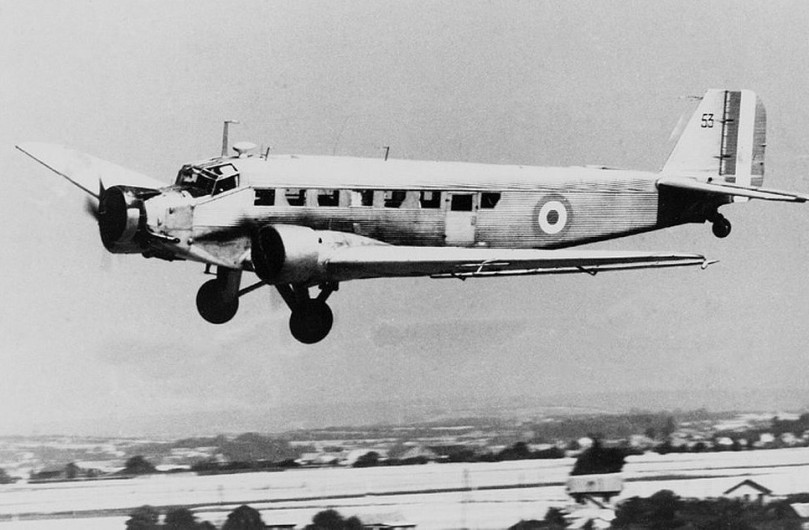
(This Toucan has an external compass blister, single main radio antenna, and a separate second antenna wire. The rooftop fits varied greatly.)
The Ju-52’s wartime radio used a wire antenna running from the tall forward blade to the tail. This was retained, but later production or field-modified Toucans sometimes had two wire antennas from the forward blade or a second blade-&-wire assembly.
Another small change was that the Ju-52’s groundcrew handles on the wingtips were deleted on the Toucan (some late-WWII actual Ju-52s had them missing as well, to save production time). The Toucan had a slightly modified tailwheel.
France began planning for a restart of Ju-52 production at Colombes during the summer of 1945, even as the Pacific part of WWII was still in progress.

(AAC.1 Toucans under construction.)
The first AAC.1 Toucan was completed in August 1945. Altogether, there were 415 Toucans built before production ended in 1948. Additionally, 28 of the 40 ex-Luftwaffe Ju-52s taken by France were reconditioned by AAC, with their equipment fit being brought in line with the new post-WWII production planes.

(Toucans under production in 1947. The tank on the cockpit firewall is the centreline engine’s oil supply.)
French air force
The Armée de l’Air, or French Air Force, was the first recipient. Altogether 216 of the 443 Toucans built went to Armée de l’Air service. Some of these shifted from civilian use to the air force and vice-versa.

The transport group IV/15 (later GT 3/61) ‘Poitou’ converted to the AAC.1 in early 1946, replacing WWII lend-leased UC-45 Expeditors. It was soon followed by GT 1/34 ‘Béarn’; destined to heavily use the type in combat during the Indochina War. GT 2/62 ‘Franche-Conté’ and other units followed.

(Like any other “tail-dragger” transport of the WWII era, the AAC.1 Toucan’s cargo door was not parallel to the runway and harder to load than Cold War-era transports.)
One interesting user was ELA Vaucluse at Persan-Beaumont airbase. This “composite squadron” flew a bizarre mixed bag, never more than two dozen planes total, of the AAC.1 (the Ju-52 copy), the NC-701 Martinet (the Si-204 copy), the MS.500 Criquet (the Fi-156 Storch copy), ex-Luftwaffe Bf-108s, ex-US Army C-47 Skytrains, ex-RAF Lysanders, ex-Royal Navy Barracudas, and the lone Hurel-Dubois HD.31 completed.
It was found that the landing gear could accept commercial American DC-3 tires and these were substituted for the WWII German-designed tires. The entire forward undercarriage on many Toucans was later strengthened as the planes were flown off of grass airstrips more frequently than had been envisioned. Another field modification done to some (not all) Toucans was to lengthen the two centreline engine exhaust pipes and add a vent which prevented a backpressure from forming. Many Toucans, especially those which served in the Algerian War, also had a new postwar-design oil tank thermometer.
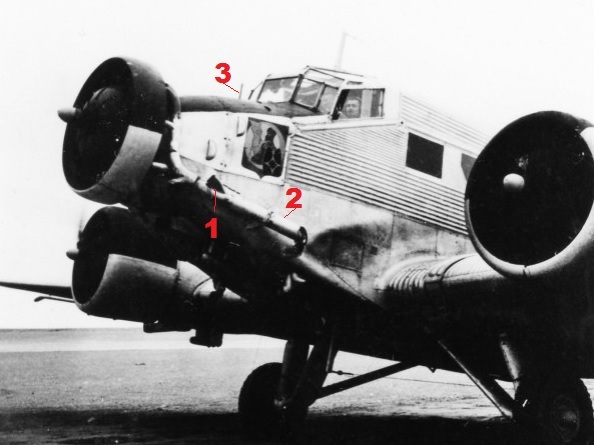
(A Toucan in French Algeria showing 1) the vent 2) the extended exhaust and 3) the new oil thermometer.)
The Toucan was surprisingly useful and well-liked in the French air force, both strategically and personally by individual pilots. Its three-engine safety was a bonus when flying across the Mediterranean from France proper to French Algeria.
In the mid-1950s, the AAC.1 had largely been supplanted in French air force service by C-47 Skytrains and the first generation of Cold War-era transport aircraft.
As the AAC.1 Toucan’s military usefulness began to wane, some ex-French air force Toucans were passed on to organizations including ONERA (the French equivalent of NASA), IGN (the national mapping service), and the French Gendarmerie.
By the end of 1959, no transport squadron in France proper was still using the AAC.1, with the type limited to ad hoc use in training or support squadrons or in transport squadrons overseas. These were gradually eliminated in 1960. The final Armée de l’Air user overall, the multi-role group GSRA 78 in French Algeria, retired the Toucan in early 1961. The last holdout, a squadron hack in mainland France, was retired on 21 March 1962.

(AAC.1 Toucan of the Marrakech detachment at Rabat, Morocco in 1959.)
Without question, the AAC.1 succeeded in France’s original 1945 goal for the Ju-52 restart project. In 1945 the French economy was flailing and much of the country was in ruins. France could have never afforded an equal number or imported transports. Nor would it have been possible to design, test, and build a new French transport in such short of a timeframe as the AAC.1’s production run.
The AAC.1 was also important on providing an affordable plane to wean the first generation of post-WWII French airmen. For example André Turcat, the first test pilot of the prototype Concorde supersonic airliner, had learned to fly as a AAC.1 Toucan pilot many years previous.
French navy

The French navy’s air arm operated 51 of the 443 Toucans built (including some of the AAC-remanufactured Ju-52s). Curiously the French navy never called the AAC.1 by its nickname, Toucan. Instead they were called the “Julie”.

(A “Julie” of 50.S (the French Naval Academy’s squadron) during the 1950s.)
The main role was ashore-based transport, of which there were two “Julie” escadrilles (squadrons) established during the late 1940s: 31.S in mainland France and 32.S in north Africa. Each had a dozen planes. Others flew for SLAM, which was essentially a scheduled military-only airline.
Other “Julie”s were used in various roles including the French Naval Academy, Escadrille 10 (a test & experiments unit), and Escadrille 4 (a secondary aviation school in French Algeria). Some were used as shuttles between France and Great Britain, for pilots retrieving other aircraft for the post-WWII French navy. Escadrille 54.S, the French navy’s carrier-based fighter training unit, used a few as target tows. The French navy’s West African detachment at Dakar usually had a few as well.
Four of the French navy’s “Julie”s were ex-Air France airliners transferred in 1951, and others transferred from the French air force as that branch retired the AAC.1 during the late 1950s.
Three “Julie”s were fitted with dorsal turrets to train defensive aircraft gunnery; itself a dying art by this time. Two AAC.1s were refitted as ASW (anti-submarine warfare) planes with the first generation of French sonobuoys. These two planes were simply testbeds for ASW gear and tactics and no large-scale use of the Toucan in the anti-submarine role was envisioned.
The French navy was the final French military operator of the Toucan, with its last AAC.1 not leaving service until the autumn of 1962.
civilian French use
Air France operated the AAC.1 beginning in 1946. The planes typically flew “short-medium” routes; such as Paris-London, Paris-Brussels, and Toulon-Algiers. Routes in Africa were also flown with AAC.1s. Air France phased out the Toucans during the early 1950s, with the last scheduled route flown in 1953.

(In the challenging first year or two after WWII, Air France could not afford to refuse anything offered. The Dewoitine D.338 was a pre-WWII transport which was fortunate in that most were out of Europe when France fell in 1940. During WWII they were used by the Free French in the Levant and central Africa. After WWII the remaining planes passed to Air France which flew them on the Paris-Nice route until better options were available.)

(The logo of Air France on a company hangar in 1947, with a parked Toucan.)
Air France’s results with the Toucan were mixed. On one hand, just like the French military, the homebuilt Ju-52 copy enabled the airline to quickly and cheaply build up a fleet that would have otherwise been unaffordable. On the other hand, the AAC.1 had a poor safety record with the airline. It was also financially uncompetitive, partly masked by the fact that Air France was subsidized.
An interesting civilian AAC.1 operator was Cosara, a small post-WWII airline in French Indochina. In 1947, Maurice Loubière, a French veteran who had served in Indochina throughout WWII, established the airline. The first planes were two Toucans leased from STA in France. Cosara’s hub was the civilian side of the former Japanese airbase of Tan Son Nhut near Saigon. From there, the AAC.1s flew routes to Sóc Trang (an ex-Japanese airbase in far southern Vietnam), Phnom Penh in Cambodia, and Vientiane in Laos. Irregular flights were also made to Hanoi, the capital of Tonkin colony and future capital of North Vietnam.

(STA both flew Toucans and leased them to other operators including Cosara.)

(Cosara’s luxurious art-deco corporate office at 5-13 Hô Huân Nghiêp St in Saigon. This building is long gone now.)
Cosara also flew flights on behalf of the French military including casevac, transport, and resupply. These were flown at a financial loss to the company and were tremendously appreciated by French troops fighting the Indochina War. The airline was awarded the Légion d’honneur for its efforts. This appreciation did not extend back to Paris, where Cosara was viewed as an annoying competitor to Air France.

(Cosara got revenue any way it could, including “The Airplanes Of The Road”, a fleet of stylish busses in Saigon. Behind the bus is one of the C-47s which replaced Cosara’s AAC.1s.)
Cosara, Air France, and every other AAC.1 airline discovered that while during WWII the Douglas C-47 Skytrain and Junkers Ju-52 had both been militarily successful on opposing sides of the war, in postwar civilian use the German design simply could not compete commercially with demilitarized Skytrains. A C-47 was 51 kts faster than a Toucan but still had 8% better range, and (depending on how the cabin was rebuilt during demilitarization) yielded 101% – 165% of its passenger-mile revenue; all the while only having two engines needing hangar attention instead of three. DC-3 spare parts were readily available worldwide while Ju-52 components were not. There was just no way to make the math work from a business standpoint.
Another small French airline, Air Ocean, briefly flew a single Toucan. It crashed in Morocco in October 1946. Another minor user was SANA, which flew the AAC.1 alongside demilitarized Halifax WWII bombers.
foreign military users
Portugal
FAP (Portugal’s air force) operated 16 AAC.1 Toucans between 1960 – 1973. All were second-hand; either former French military or Air France planes.
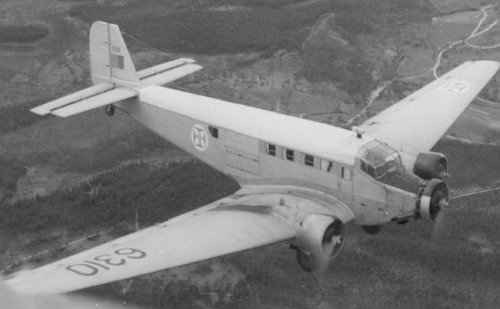
Portugal had been an operator of the original Ju-52 since 1936. After the end of WWII in 1945, these were hard to maintain without German spare parts support. In 1951, two ex-Luftwaffe Ju-52s were bought from Norway to help replenish the operational numbers, and some were re-engined with American-made Wasps, but all this was still just buying time. The sixteen Toucans in 1960 were thus a welcome relief, allowing German-built planes to be retired later in the decade.
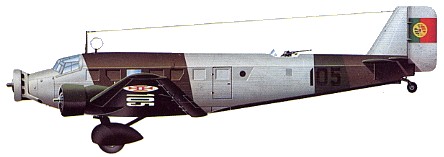
(After WWII, Portugal removed the wheel spats off its German-built Ju-52s as they were basically useless, and later also the open dorsal machine gun. French-made Toucans were built without both from the start.) (artwork via Wings Palate website)
The French-made Toucans were called “Ju Argelino” (Algerian Junkers) in Portuguese service, as the AAC.1 had by then achieved notability with the French air force in the Algerian War, and in fact, several of the Portuguese planes were delivered via direct flights from their final French bases in north Africa.
Perhaps surprisingly, given the close defense ties between Portugal and Franco-era Spain, the Portuguese never operated Spain’s postwar Ju-52 copy, the CASA 352.
In service, the Portuguese Toucans were used as paratrooper training planes, navigational trainers, and other second line roles. It is not believed any were used in Portugal’s colonial wars in Africa, or if they were, not to any useful extent. One problem was geography; for a AAC.1 to even reach Angola would have required a hopscotch from the Azores down through airports in African colonies of friendly European countries (which steadily declined as colonies gained independence and Portugal’s NATO partners frowned on its wars), or, disassembling AAC.1s, shipping them by sea, and then reassembling them in areas with limited aviation infrastructure.
The Portuguese AAC.1s had already been modified in French service to take DC-3 tires and furthermore, Portuguese mechanics discovered that various other non-critical C-47 parts could sometimes be shoehorned in to the AAC.1. Another local modification done to some, but not all, of the Toucans was a new horizontally-swinging cargo door.

Only six years after they entered Portuguese service, the AAC.1 Toucans were already viewed as obsolete. Starting in late 1966, they began to be retired as they came up for scheduled major maintenance and by 1972 were out of regular squadron service. (Quite amazingly, there was still one German-built Ju-52 in service with the Toucans in 1972.) The last Portuguese AAC.1 flight of any type was out of Tancos airbase on 3 January 1973.
Yugoslavia
The Yugoslav air force already had one flyable ex-Luftwaffe Ju-52 at the end of WWII, followed by a handful more in 1945 – 1946. In late 1945, the Yugoslav air force ordered two AAC.1 Toucans as production was restarting in France; the delivered planes were in fact diverted from what would have been the first two Air France orders. Yugoslavia exercised an option for a second pair, and then in 1950 bought four more.

Starting in 1952 they were replaced by Li-2 “Cab” transports (the Soviet DC-3 knockoff) and were passed on to JAT airlines which operated them until 1964. Today one is preserved in Belgrade.
other foreign users
Syria and Lebanon each flew a very small number of AAC.1s during the 1950s however the Toucan was never an important asset to either air force.
the Toucan in combat
the Madagascar conflict
The “colonial wars” European countries fought in Africa after WWII are often forgotten today, and none more than the violent 1947 – 1949 Malagasy Uprising which France waged against an independence movement in its Madagascar colony. Today outside of Madagascar, this war is all but ignored. At the time it was a significant conflict and also the first use of the “new” AAC.1 Toucan in combat.

(French Toucan crew in Madagascar.)
The French air force’s 20 Toucans on the island were helped in the transport role by chartered Air France AAC.1s. Besides transport and casevac missions, French air force AAC.1s also flew makeshift bombing sorties. Experimentally, some had external bomb racks used with leftover Luftwaffe bombs in French storage. One account had a AAC.1 carrying over 1 ton of bombs, which would be remarkable for the Ju-52 airframe.
A more expedient choice was “box bombs”, empty WWII shipping crates packed full of explosives and shoved out the cargo door. These were not novelty or piecemeal type raids but rather a sustained effort. Madagascar today estimates that over 1,000 civilians were killed by AAC.1 Toucan bombing missions.
The limited number of AAC.1s deployed to Madagascar – both military and the chartered Air France Toucans – had a poor safety record with multiple crashes . The Toucans often flew out of bases abandoned by the allies after the “Ironclad” operation during WWII, and in some cases, out of pre-WWII airstrips intended for single-engine biplanes.
the Indochina War

(AAC.1 Toucan over the Mekong River during the Indochina War.)
France’s 1946 – 1954 conflict in its five Indochina colonies is the war most associated with this postwar copy of the Ju-52.
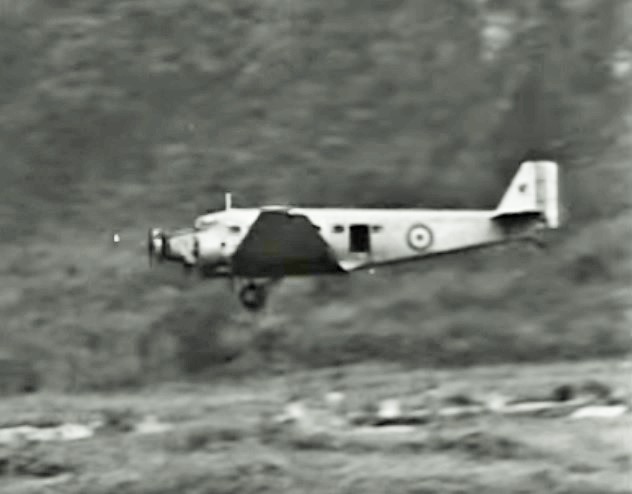
(AAC.1 Toucan near Hoah Binh, today in Vietnam, during 1952.)
GT 1/34 ‘Béarn’ was a prolific user of the AAC.1 and probably the squadron most associated overall with the Toucan in popular imagination. It was already a AAC.1 operator, flying out of the French zone of occupied Germany in early 1946. In Indochina, it was based at Nha Trang with smaller field bases at Tan Son Nhut and Da Nang. During the Indochina War, ‘Béarn’ flew the AAC.1 in country from February 1946 until August 1952 as its lone type, and then from September 1952 to December 1952 alongside C-47 Skytrains, which completely replaced the Toucan in January 1953. The ‘Béarn’ air group fought the whole Indochina War from start to finish and did not leave southeast Asia until July 1956.

(The red and yellow badge of GT 1/34 ‘Béarn’.) (photo by Ralph Evain)
GT 2/62 ‘Franche-Conté’ flew Toucans in Indochina from August 1949 until October 1951, when they were replaced by C-47 Skytrains. This group flew mostly out of Haiphong on the Tonkin Gulf.

(A C-47 Skytrain of ‘Franche-Conté’ alongside the AAC.1 Toucans which it replaced.)
The short-lived GT 3/64 ‘Tonkin’ air group flew the AAC.1 Toucan from October 1947 through July 1948, almost exclusively in the areas around Hanoi. Actually just an overstrength squadron, ‘Tonkin’ was rolled into ‘Béarn’ in August 1948, with that group keeping its nickname but becoming GT 1/64.

(An AAC.1 Toucan deploying paratroopers over Tonkin colony.)
Operation “Dedale” during January 1947 saw heavy use of AAC.1 Toucans. Ten AAC.1s alongside ten C-47 Skytrains dropped paratroopers over Nam Ðinh. The ten Toucans then flew four dozen para-supply and reconnaissance missions to support the paratroopers. All ten Toucans were hit by Viet Minh AA guns, an average of three times each with some more than that.

(A “kicker” sends supplies out the right side cargo door of a Toucan in Indochina. This photo also shows the rear bulkhead of the passenger cabin. The supply pack’s parachute was opened by a static line.)

(A wounded French soldier leaves through the left side passenger door at Hanoi.)
Perhaps the largest concentrated use of Toucans during the war came during operation “Lea” during the autumn of 1947. Conducted in Tonkin colony (the northern part of modern Vietnam) near Hanoi, AAC.1s made paratrooper drops near Cho Mói and Bac Kan. The entire GT 3/64 ‘Tonkin’ unit flew this operation, as did Toucans from other units. “Lea” was a bold attempt to end the Indochina War in a lightning flash by placing airborne forces directly into the most strongly-held communist area; with one of the objectives being the capture or elimination of Ho Chi Minh himself. The operation lasted a month and failed.

(A Toucan takes off from an improvised dirt runway during the Indochina War.)
AAC.1 Toucans were used as makeshift bombers in Indochina. The Toucan lacked the trapdoor “bomb bay” of prewar and early-WWII Ju-52s, but the AAC.1’s wings were strong enough to accept locally-made racks for a dozen each small bombs. There was no method whatsoever of aiming them, other than a best guess from the cockpit.
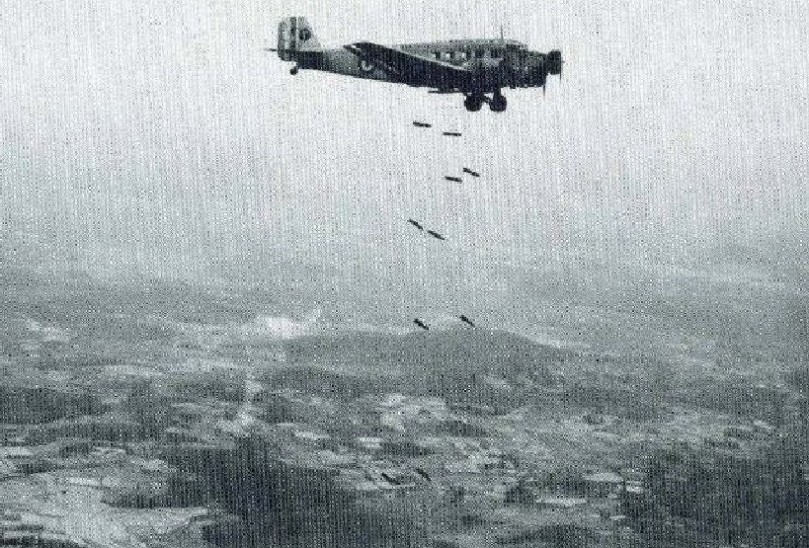
(AAC.1 Toucan bombing run over French Indochina.)
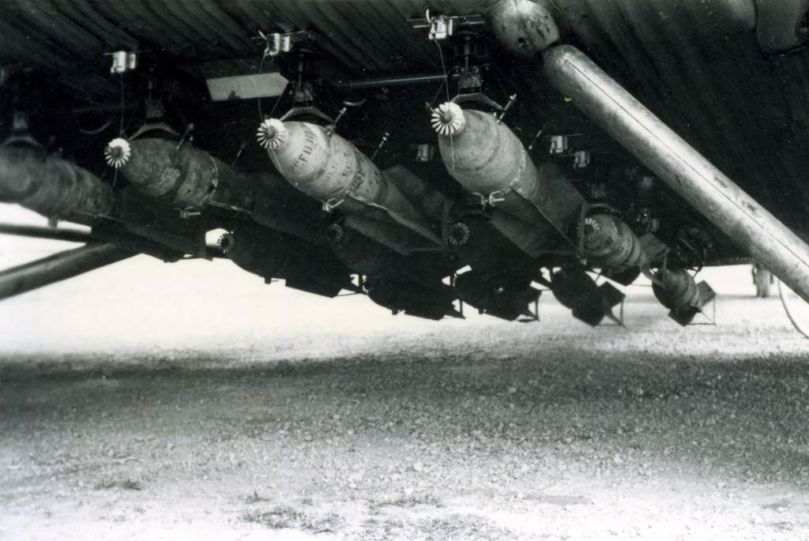
(Detail of one of the bomb racks on a AAC.1.)
The bombs above look to be the pre-WWII French 50KG Mle. A type. These weighed 88 lbs and had a filling of 22 lbs of melenite – dinitroapthalene explosive. These 1930s-era bombs were of low suitability to Cold War-era warplanes and the French considered their expenditure in the 1950s irrelevant. American anti-personnel bombs left over from WWII were also used.
A more expedient method used was the “box bombs” as employed earlier in Madagascar. In Indochina, the French also used leftover WWII shipping tins refilled with napalm in the same manner. Both of these makeshift weapons were shoved out of the cargo door while the plane was at low altitude.

(Napalm tins being pushed out of a Toucan over Viet Minh positions.) (photo by Albert Grandolini)
One of the more imaginative ways to use the AAC.1 in a ground strike role was thought up by a crew of the ‘Béarn’ unit: the Toucan flew at 30′ altitude with a steel chain dragging from the cargo door, to snag telegraph lines in areas overrun by the Viet Minh.
One AAC.1 Toucan is definitely known to have been shot down by Viet Minh AA fire, a plane of the ‘Béarn’ unit downed near Cao Bàng in October 1947. Many others were written of due to cumulative small arms hits, or rough landings, or mechanical failures.
The French navy made limited use of its “Julie”s during the conflict. Escadrille 28.F, a strike squadron flying American WWII P4Y Privateer four-engined bombers, operated three AAC.1s as logistics planes out of naval air bases in French Indochina.
Mechanically, the performance of the Toucans in Indochina was not the finest of the Ju-52’s family history. The AAC.1s had persistent problems with the air-cooled engines overheating, due to flying low and slow in hot and humid weather. As the war dragged on, Toucans were increasingly flown with the engine covers removed. In November 1947 it was reported that 2 out of every 3 Toucans in Indochina was grounded with problems in at least one engine.

(A Toucan which ran off the grass runway during the Indochina War.)
Within the French air force overall, the Toucan was viewed only as a stop-gap and this was especially true in Indochina after American arms shipments began. As soon as possible, C-47 Skytrains were substituted for AAC.1 Toucans.

(A Toucan in French Indochina.)
An American intelligence report (NIE #91 of June 1953) stated there were still 15 Toucans flying in French Indochina in 1953: three in the northern Tonkin colony where the heaviest fighting was taking place, eight in the central Annam colony, and another four in the south around Saigon. This was apparently fairly accurate as the French order of battle for early 1953 listed 16 operational AAC.1s still in the theatre.

(Taken in 1953, this photo shows South Vietnamese airborne troops training on a French air force C-47 Skytrain with a AAC.1 Toucan in the background.)
In July 1954 France and the Viet Minh signed the Geneva Accords ending the conflict and starting France’s withdrawal from Indochina. It is unknown how many AAC.1s were still flightworthy by then but it was not many, if any at all. Out of the five French colonies four new nations were created (Laos, Cambodia, South Vietnam, and North Vietnam) of which all but the last received leftover military equipment as the French left. However none of these air forces operated AAC.1s.
the Algerian War

The final conflict that saw use of the AAC.1 was France’s 1954 – 1962 colonial war in north Africa.

(A Toucan over the Sahara during the Algerian War. The AAC.1s often had roofs of heat-retardant white during the conflict.)
ESRA 77 was a AAC.1-operating squadron originally based deep in the heart of Africa at Bangui; then in the French colony of Ubangi-Shari (today, the Central African Republic). In 1957, it relocated to Ft. Lamy (today, N’Djamena, Chad) flying missions supporting French efforts against Algerian separatists. In 1959, this unit merged with several others to form GAMOM 85, a composite transport / reconnaissance / ground attack unit. Now based out of Tindouf in French Algeria, it flew Toucans until 1960.
GSRA 78 was the best-known AAC.1 unit during the Algerian War. Based out of Tindouf in French Algeria, it was created as ESRA 78 in June 1956 with the initial element being four AAC.1 Toucans previously based in Tunis. ESRA 78 was considered something of the “guinea pig” for the concept of using the AAC.1 in the over-desert reconnaissance role, and was very successful. Additional Toucans were added and the unit grew in strength, being uprated from squadron to full air group.

(GSRA 78’s logo was a desert warrior and camel.)
In late 1957, C-47 Skytrains began to replace AAC.1 Toucans in GSRA 78 however the type was never fully phased out until 1961. GSRA 78 itself relocated back to the French homeland in 1962 and was abolished in 1963.
During the autumn of 1956 a detachment of GSRA 78’s Toucans was assigned to the first French atomic bomb test at Reganne Oasis in the Sahara desert. The planes surveyed the test site and downwind areas prior to the 70kT detonation in 1960, by which time other transports had relieved the Toucans.
In Algeria, the main role of the Toucans was visual reconnaissance. The safety of multiple engines was appreciated over the empty Sahara. AAC.1s were used to pinpoint rebel camel caravans for elimination by other aircraft, or to give advance warning of attacks on French outposts. Naturally, just like in Indochina, transport and casevac missions were also important. There were also airborne resupply and paratrooper drops.

(A Toucan of GT 1/62 ‘Alger’ near Philippeville (today, Skikda), French Algeria with a static line rigged in the cargo door.)
The French navy flew some of its “Julie”s in support of the war. A few were modified for SIGINT (signals intelligence) with gear to intercept and localize radios used by insurgents ashore. Others were used in the ship-spotting role, to identify merchant vessels suspected of smuggling weapons to the rebels. One was used in a non-combat role to spray insecticide against locusts.
Some Toucans of both ESRA 77 and GSRA 78 were fitted with bomb racks. However in the autumn of 1957 the French air force prohibited further use of the Toucan as a bomber after a strange incident; one of the AAC.1s was flying too slow and low and was damaged by shrapnel from its own bombs.

(A Toucan with two propellers removed in French Algeria. American prefabricated steel matting left over from WWII was used by France in both the Indochina and Algerian wars.) (photo via Claissac)
The French toyed with the idea of making a gunship AAC.1 for use in Algeria. Various armament fits were considered, including pintle-mounted machine guns, air-to-ground rockets, and a 20mm autocannon in the cargo door. None of these plans were ever followed through.

(AAC.1 Toucans at La Sénia airbase near Oran in French Algeria. During WWII this base had been used by the Vichy military and then the US Army. After WWII it was used again by the French air force until Algeria’s independence. Today in 2020, Ahmed Bin Bella Airport is on the location.)
postscript
The relevance of Ateliers Aéronautique Colombes ended with the last AAC.1 rolling off the assembly line in 1948.

(During the company’s brief existence, AAC employees formed a sports club. This was their float in a May 1946 parade.)
In 1946, AAC signed a cooperation agreement with the Fruehauf company, a manufacturer of aluminum truck trailers. When AAC.1 production ended in 1948, Fruehauf took over much of the aluminum stamping machinery which had been used to build Toucans.
Ateliers Aéronautique Colombes was dissolved in 1949 and rolled into SNCAN which later became Nord Aviation, and after it merged with Sud Aviation, the famous Aérospatiale of the latter Cold War era. However none of these companies had any link to AAC other than legally being successor firms. AAC’s machinery was outdated and its factory (which no longer exists) unsuitable for making modern warplanes, and AAC had no influence on any later French design.

(A Toucan being built in late 1945 or early 1946. The tooling AAC inherited from the German occupation was oriented to pre-WWII “stamp-&-rivet” techniques and of little value to modern French aerospace.) (photo via Life magazine)
the van myth

Citroën’s Type H van, introduced in 1947, is nicknamed the “Junkers” in France on account of its shape and corrugated body panels. Contrary to myths still somewhat popular in France, these were not built alongside AAC.1s and certainly did not use scrapped Ju-52 parts.
legacy
Certainly the Ju-52’s main story will always be with Germany during WWII. However the AAC.1 was a success in its own right after the war. Particularly during the Indochina War, it held the line when nothing else was available, most critically during the first major Viet Minh offensive in December 1946. General Louis-Constant Morlière, the commander in Tonkin colony, remarked “Hanoi was saved by the Ju-52”.

(Abandoned AAC.1 in Algeria.)

Thanks, that was a very detailed explanation. Some ingenious and interesting uses of the aircraft that was so successful in the Second World War – certainly what it’ll be most remembered for.
LikeLiked by 1 person
Again a very informative story. A big thanks for the story.
LikeLiked by 1 person
And of course the #1 use for these old birds.
WWII movies!
LikeLiked by 1 person
4 wars has already begun…
LikeLike
Great site, great info and stories, well done.
LikeLiked by 1 person
thank you
LikeLike
Dear jwh1975, thank you for this very interesting article! We have an AAC.1 in the Deutsches Museum in Munich and would like to use some of the photographs you showed here in the exhibition. Do you have high res copies? i would be very grateful if you would contact me.
Best regards
A
LikeLike
All of the photos I used I found online, so I dont have hard copies unfortunately.
LikeLike
Just working on the 1/.72 Italieri model of the Toucan..I had alot of questions about the defensive armament that might have been used/. Your article answered most of them,,,thanks! I am trying to make it a medical evac aircraft, rather than strictly cargo,
LikeLiked by 1 person